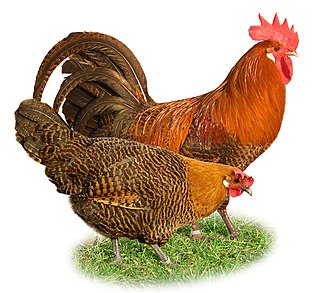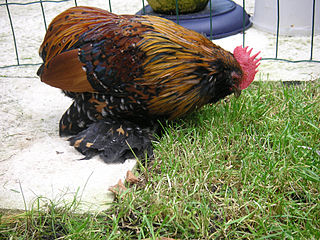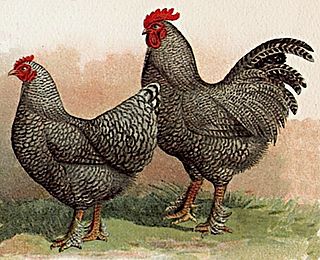Related Research Articles

Mechelen is a city and municipality in the province of Antwerp in the Flemish Region of Belgium. The municipality comprises the city of Mechelen proper, some quarters at its outskirts, the hamlets of Nekkerspoel (adjacent) and Battel, as well as the villages of Walem, Heffen, Leest, Hombeek, and Muizen. The Dyle flows through the city, hence it is often referred to as the Dijlestad.

The Rhode Island Red is an American breed of domestic chicken. It is the state bird of Rhode Island. It was developed there and in Massachusetts in the late nineteenth century, by cross-breeding birds of Oriental origin such as the Malay with brown Leghorn birds from Italy. It was a dual-purpose breed, raised both for meat and for eggs; modern strains have been bred for their egg-laying abilities. The traditional non-industrial strains of the Rhode Island Red are listed as "watch" by The Livestock Conservancy. It is a separate breed to the Rhode Island White.

The Braekel or Brakel is a traditional Belgian breed of chicken. It is thought to have originated in the area of Brakel, in the Flemish province of East Flanders, for which it is named. There is a bantam version of the Braekel. The Campine of the United Kingdom derives from it.

The Bouvier des Flandres is a herding dog breed originating in Flanders, Belgium. They were originally used for general farm work including cattle droving, sheep herding, and cart pulling, and nowadays as guard dogs and police dogs, as well as being kept as pets. The French name of the breed means, literally, "Cow Herder of Flanders", referring to the Flemish origin of the breed. Other names for the breed are Toucheur de Boeuf, Vlaamse Koehond, and Vuilbaard.

The Boulonnais, also known as the "White Marble Horse", is a draft horse breed. It is known for its large but elegant appearance and is usually gray, although chestnut and black are also allowed by the French breed registry. Originally there were several sub-types, but they were crossbred until only one is seen today. The breed's origins trace to a period before the Crusades and, during the 17th century, Spanish Barb, Arabian, and Andalusian blood were added to create the modern type.

The Barbu d'Uccle or Belgian d'Uccle, Dutch: Ukkelse Baardkriel, is a Belgian breed of bearded bantam chicken. It was first bred in the town of Uccle on the outskirts of Brussels, in central Belgium, in the early years of the twentieth century. It is a true bantam, with no standard-sized large fowl counterpart, and is one of eleven Belgian true bantam breeds.

The Campine is a breed of domestic chicken originating in the northern part of Belgium. It is named for the Campine region of north-eastern Belgium and south-eastern Netherlands. It was known there as the Kempisch Hoen.

The Crèvecœur is an endangered historic breed of crested chicken from the Pays d'Auge, in the Calvados département of Normandy, in north-western France. It is named after the commune of Crèvecœur-en-Auge. It is related to the La Flèche and to other Norman breeds such as the Caumont and Caux and the extinct Pavilly; the Merlerault was formerly considered a sub-type of the Crèvecœur.

The Barbu d'Everberg, Dutch: Everbergse Baardkriel, is a Belgian breed of bantam chicken. It is a tailless variant of the Barbu d'Uccle, and was bred in about 1906 at the Château d'Everberg, at Everberg in the municipality of Kortenberg, between Brussels and Leuven. It is among the most endangered chicken breeds in Belgium, and in 2010 its conservation status was classed as "critical". It is a true bantam, with no large counterpart. Cocks weigh 700–800 grams, and hens 550–650 g.

The Barbu d'Anvers, Dutch: Antwerpse baardkriel, is a breed of bantam chicken from Belgium. It is a true bantam, and has no full-sized counterpart; males weigh about 700 grams and hens about 600 g. The Barbu d'Anvers is one of the oldest bantam breeds, and is thought to have originated in the province of Antwerp in northern Flanders. It is the only Belgian bantam breed not threatened with extinction. In the United States it may be called the Antwerp Belgian or Belgian Bearded d'Anvers.
The Belgian Bantam, Dutch: Belgisch kriel, French: Naine belge, is a breed of bantam chicken from Belgium. It is a true bantam, and has no full-sized counterpart; cocks weigh about 650 grams and hens about 550 g. It is in danger of extinction; in 2010 a total of 168 birds were counted in the whole of Belgium. Fourteen colour patterns are recognised in the European standard.

The Alsacienne or French: Poule d'Alsace is a breed of domestic chicken from Alsace, in eastern France. It was selectively bred in the 1890s, at a time when Alsace was part of the German Empire. Unlike most other French breeds, it has not been cross-bred with imported Oriental stock.

The Ardennaise, French: Poule ardennaise, is a breed of domestic chicken from the Ardennes plateau, in Belgium and eastern France. Its range extends from the Pays de Herve in Wallonia to the French département of Ardennes, and includes the Fagnes, the Famenne, and the valleys of the Amblève, the Ourthe and the Semois.

The Bielefelder Kennhuhn or Bielefelder is a German breed of domestic chicken. It was developed in the area of Bielefeld in the 1970s by Gerd Roth, who cross-bred birds of Malines and Welsumer stock with American Barred Rocks to create the breed. Like other breeds with Barred Rock parentage, it is auto-sexing – chicks of different sexes can be distinguished by their colour. There is a bantam version, the Bielefelder Zwerg-Kennhuhn.
The Bassette Liégeoise or Bassette is a breed of large bantam chicken from Belgium. It is larger than most bantams, but much smaller than full-sized breeds; cocks weigh about 1000 grams and hens about 900 g. Like most Belgian bantam breeds, it is in danger of extinction. Eighteen colour patterns are officially recognised; many of them are rare.

The Malines, Dutch: 'Mechelse Koekoek', is a Belgian breed of large domestic chicken. It originates from the area of Mechelen, in the province of Antwerp in Flanders, for which it is named. It was created in the nineteenth century by cross-breeding local cuckoo-patterned farm chickens with various different types of imported Oriental chicken. With the Jersey Giant, it is among the heaviest of all chicken breeds. It is valued for the quality of its meat, which is pale in colour and fine-textured.

The Brugse Vechter, French: Combattant de Bruges, is an endangered Belgian breed of gamecock. It dates from the early nineteenth century, and was bred specifically for cock-fighting. It named for its area of origin, that of the city of Bruges (Brugge), in West Flanders in the north-east of Belgium. It is one of three Belgian breeds of fighting-cock, the others being the Luikse Vechter and the Tiense Vechter. It is a hardy breed, but the birds are often aggressive; those reared for exhibition may show less aggression.
The Luikse Vechter, French: Combattant de Liège, is an endangered Belgian breed of gamecock. It dates from the late nineteenth century, and was bred specifically for cock-fighting. It named for its area of origin, that of the city of Liège in Wallonia, in eastern central Belgium. It is one of three Belgian breeds of fighting-cock, the others being the Brugse Vechter and the Tiense Vechter.
The Tiense Vechter, French: Combattant de Tirlemont, is a critically-endangered Belgian breed of gamecock. It dates from the late nineteenth century, and was bred specifically for cock-fighting. It named for its area of origin, that around the city of Tienen in Flemish Brabant, in eastern central Belgium. It is one of three Belgian breeds of fighting-cock, the others being the Brugse Vechter and the Luikse Vechter.

The Augsburger is an endangered German breed of domestic chicken. It originates from the area of the city of Augsburg, in the Swabian region of the state of Bavaria, in southern Germany. It was bred in the nineteenth century, and derives mostly from the French La Flèche breed. It is the only chicken breed of Bavarian origin.
References
- 1 2 3 4 5 6 7 8 N. Moula, M. Jacquet, A. Verelst, N. Antoine-Moussiaux, F. Farnir, P. Leroy (2012). Les races de poules belges (in French). Annales de Médecine Vétérinaire156: 37-65. Accessed January 2017.
- 1 2 Liste des races et variétés homologuée dans les pays EE (28.04.2013). Entente Européenne d’Aviculture et de Cuniculture. Archived 16 June 2013.
- ↑ Breed data sheet: Vlaanderse Koekoek/Belgium. Domestic Animal Diversity Information System of the Food and Agriculture Organization of the United Nations. Accessed January 2017.
- ↑ Breed data sheet: Coucou des Flandres/France. Domestic Animal Diversity Information System of the Food and Agriculture Organization of the United Nations. Accessed January 2017.